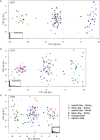Adaptive genetic variation underlies biocomplexity of Atlantic Cod in the Gulf of Maine and on Georges Bank
- PMID: 31125344
- PMCID: PMC6534298
- DOI: 10.1371/journal.pone.0216992
Adaptive genetic variation underlies biocomplexity of Atlantic Cod in the Gulf of Maine and on Georges Bank
Abstract
Atlantic cod (Gadus morhua) populations in the Gulf of Maine (GoM) are at a fraction of their historical abundance, creating economic hardships for fishermen and putting at risk the genetic diversity of the remaining populations. An understanding of the biocomplexity among GoM populations will allow for adaptive genetic diversity to be conserved to maximize the evolutionary potential and resilience of the fishery in a rapidly changing environment. We used restriction-site-associated DNA sequencing (RADseq) to characterize the population structure and adaptive genetic diversity of five spawning aggregations from the western GoM and Georges Bank. We also analyzed cod caught in the eastern GoM, an under-sampled area where spawning aggregations have been extirpated. Using 3,128 single nucleotide polymorphisms (SNPs), we confirmed the existence of three genetically separable spawning groups: (1) winter spawning cod from the western GoM, (2) spring spawning cod, also from the western GoM, and (3) Georges Bank cod. Non-spawning cod from the eastern GoM could not be decisively linked to either of the three spawning groups and may represent a unique component of the resource, a mixed sample, or cod from other unsampled source populations. The genetic differentiation among the three major spawning groups was primarily driven by loci putatively under selection, particularly loci in regions known to contain genomic inversions on linkage groups (LG) 7 and 12. These LGs have been found to be linked to thermal regime in cod across the Atlantic, and so it is possible that variation in timing of spawning in western GoM cod has resulted in temperature-driven adaptive divergence. This complex population structure and adaptive genetic differentiation could be crucial to ensuring the long-term productivity and resilience of the cod fishery, and so it should be considered in future management plans.
Conflict of interest statement
The authors have declared that no competing interests exist.
Figures






Similar articles
-
Low-coverage whole-genome sequencing reveals molecular markers for spawning season and sex identification in Gulf of Maine Atlantic cod (Gadus morhua, Linnaeus 1758).Ecol Evol. 2021 Jul 14;11(15):10659-10671. doi: 10.1002/ece3.7878. eCollection 2021 Aug. Ecol Evol. 2021. PMID: 34367604 Free PMC article.
-
Highly localized divergence within supergenes in Atlantic cod (Gadus morhua) within the Gulf of Maine.BMC Genomics. 2017 Mar 31;18(1):271. doi: 10.1186/s12864-017-3660-3. BMC Genomics. 2017. PMID: 28359300 Free PMC article.
-
Novel signals of adaptive genetic variation in northwestern Atlantic cod revealed by whole-genome sequencing.Evol Appl. 2019 Sep 13;12(10):1971-1987. doi: 10.1111/eva.12861. eCollection 2019 Dec. Evol Appl. 2019. PMID: 31700539 Free PMC article.
-
Large-scale sequence analyses of Atlantic cod.N Biotechnol. 2009 Jun;25(5):263-71. doi: 10.1016/j.nbt.2009.03.014. Epub 2009 Apr 5. N Biotechnol. 2009. PMID: 19491044 Review.
-
Hemoglobin polymorphisms in Atlantic cod--a review of 50 years of study.Mar Genomics. 2012 Dec;8:59-65. doi: 10.1016/j.margen.2012.03.005. Epub 2012 May 1. Mar Genomics. 2012. PMID: 23199881 Review.
Cited by
-
SNP genotyping reveals substructuring in weakly differentiated populations of Atlantic cod (Gadus morhua) from diverse environments in the Baltic Sea.Sci Rep. 2020 Jun 16;10(1):9738. doi: 10.1038/s41598-020-66518-4. Sci Rep. 2020. PMID: 32546719 Free PMC article.
-
Genomic analysis reveals neutral and adaptive patterns that challenge the current management regime for East Atlantic cod Gadus morhua L.Evol Appl. 2020 Sep 5;13(10):2673-2688. doi: 10.1111/eva.13070. eCollection 2020 Dec. Evol Appl. 2020. PMID: 33294016 Free PMC article.
-
Dynamic Outlier Slicing Allows Broader Exploration of Adaptive Divergence: A Comparison of Individual Genome and Pool-Seq Data Linked to Humic Adaptation in Perch.Mol Ecol. 2025 Jan 23;34(4):e17659. doi: 10.1111/mec.17659. Online ahead of print. Mol Ecol. 2025. PMID: 39846218 Free PMC article.
-
Genome-wide SNPs reveal novel genetic relationships among Atlantic cod (Gadus morhua) from the south coast of Newfoundland, Canada (subdivision 3Ps), Northern cod stock complex, and Gulf of St Lawrence.PLoS One. 2025 Mar 14;20(3):e0317768. doi: 10.1371/journal.pone.0317768. eCollection 2025. PLoS One. 2025. PMID: 40085548 Free PMC article.
-
Low-coverage whole-genome sequencing reveals molecular markers for spawning season and sex identification in Gulf of Maine Atlantic cod (Gadus morhua, Linnaeus 1758).Ecol Evol. 2021 Jul 14;11(15):10659-10671. doi: 10.1002/ece3.7878. eCollection 2021 Aug. Ecol Evol. 2021. PMID: 34367604 Free PMC article.
References
-
- Hauser L, Carvalho GR. Paradigm shifts in marine fisheries genetics: ugly hypotheses slain by beautiful facts. Fish Fish. 2008;9: 333–362. https://onlinelibrary.wiley.com/doi/pdf/10.1111/j.1467-2979.2008.00299.x - DOI
-
- Ward RD, Woodwark M, Skibinski DOF. A comparison of genetic diversity levels in marine, freshwater, and anadromous fishes. J Fish Biol. Wiley/Blackwell (10.1111); 1994;44: 213–232. 10.1111/j.1095-8649.1994.tb01200.x - DOI
-
- DeWoody JA, Avise JC. Microsatellite variation in marine, freshwater and anadromous fishes compared with other animals. J Fish Biol. Wiley/Blackwell (10.1111); 2000;56: 461–473. 10.1111/j.1095-8649.2000.tb00748.x - DOI
Publication types
MeSH terms
Associated data
LinkOut - more resources
Full Text Sources

